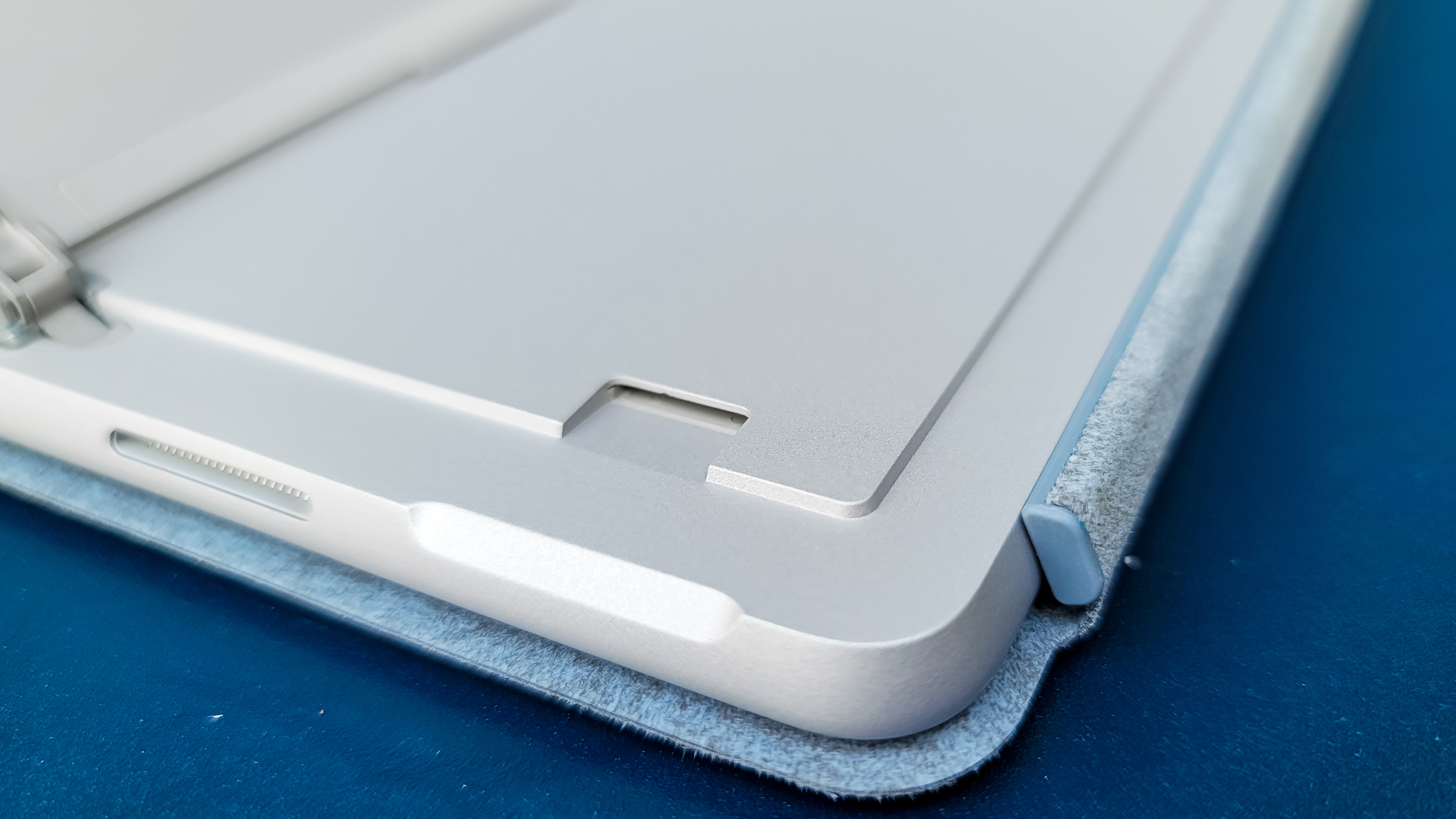
Editor's Note
• Original review date: October 2021
• Launch price: $399 / £369 / AU$629
• Surface Go 4 is available - but there's a catch
Update – August 2024: Unsurprisingly, Microsoft has followed up the Surface Go 3 with the Surface Go 4 - but what is surprising is that the Go 4 is aimed at businesses, unlike previous models which were mainly targeted at budget-conscious consumers. Because of this, and the fact that the Go 3 is now three years old, if you're looking for a cheap Windows 11 2-in-1 device, Microsoft doesn't currently have a product for you. A very odd choice. Instead, I would recommend the Lenovo IdeaPad Duet 5 Chromebook for pure value for money. If you don't want a Chromebook, then the Lenovo Yoga 9i Gen 8 is a good Windows 11 2-in-1 laptop, though it is more expensive.
Original review follows.
Two-minute review
The Surface Go 3 is Microsoft’s latest attempt to bring its line of Windows tablets and laptops to a more budget-conscious audience, especially now that learning and working from home is becoming so prolific. And, even for people that don’t have to do much serious work from home, having a small Windows 11 device like this that you can easily bring with you wherever you go is pretty appealing, and could serve as a good competitor to the iPad mini.
However, while the introductory price of just $399 / £369 / AU$629 may sound appealing, you’re going to have to add at least $99 / £118 / AU$199 to the equation if you want the keyboard, and even then you’re left with a $500 device that has hardware that’s barely capable of handling all the best parts of Windows 11 – 4GB is not going to cut it anymore on anything but a Chromebook.
You can get it with up to an Intel Core i3 processor and 8GB of RAM, but with a price of $629 (£569, about AU$870) – again not including the price of the Type Cover – it starts making less sense when compared to other budget Windows laptops, Windows laptops that will have hardware that is way more adept at the multitasking that we all need these days.
That being said, the Surface Go 3 does do some things incredibly well. The hinge on the back is still as sturdy as ever and it has one of the best webcams we’ve used in a laptop of any price point – let alone one that starts at just $399. If the main thing you’re going to be using your computer for is video calling and you want a device that can do it on the go, you can’t really go wrong with the Surface Go 3. Just don’t expect to do much else while you’re talking.
But this all adds up to a device that’s kind of hard to recommend. It definitely works, and Windows faithfuls that don’t want to learn ChromeOS or iPadOS will be able to get some work done. But, at this price point, a Chromebook or an entry-level iPad is simply going to be better for most people, as those operating systems are way better at performing on the low-end hardware found here.
Price and availability
Here is the Surface Go 3 configuration sent to TechRadar for review:
CPU: 1.3GHz Intel Core i3-10100Y (dual-core, 8MB Intel Smart Cache, up to 3.9GHz with Turbo Boost)
Graphics: Intel UHD Graphics 615
RAM: 8GB LPDDR3
Screen: 10.5-inch FHD (1,920 x 1,280) touch
Storage: 128GB SSD (PCIe, NVMe, M.2)
Ports: 1x USB-C 3.1, microSD card reader, combi audio jack, Surface Connect port
Connectivity: Wi-Fi 6; Bluetooth 5.0
Camera: 1080p IR Webcam
Weight: 1.2 pounds (544g)
Size: 9.65 x 6.9 x 0.33 inches (245 x 175 x 8.3 mm, W x H x D)
The Surface Go 3 is available today starting at $399 (£369, AU$629). For that entry-level price tag you’ll get an Intel Pentium 6500Y processor, 4GB of RAM and a 64GB eMMC drive. That is incredibly affordable, especially for a Surface device, but our advice is to, well, not buy that one.
At a minimum, you should probably go for the mid-range spec, which will get you the same processor, but with 8GB of RAM and an actual SSD – with 128GB of storage. Not only should you have 8GB of RAM at a minimum with Windows 11, but that SSD is going to load programs so much faster than the eMMC drive found in the starting tier.
You can max it out with a dual-core Intel Core i3 CPU, 8GB of RAM and the same 128GB SSD for $629 (£569, about AU$870). And, well, if you need something more powerful than that, you should just go with the Surface Pro 8, which is so much better in every conceivable way – it almost feels like the two devices were made by different companies.
Throughout our time with the Surface Go 3, we keep asking ourselves why anyone would buy this thing when something like the Asus Chromebook Flip is about the same price, and will just be a better experience all around. Chromebooks sometimes get a bad rap, but devices like the Surface Go 3 are probably the best advertisement that Google could get for its laptops.
Design
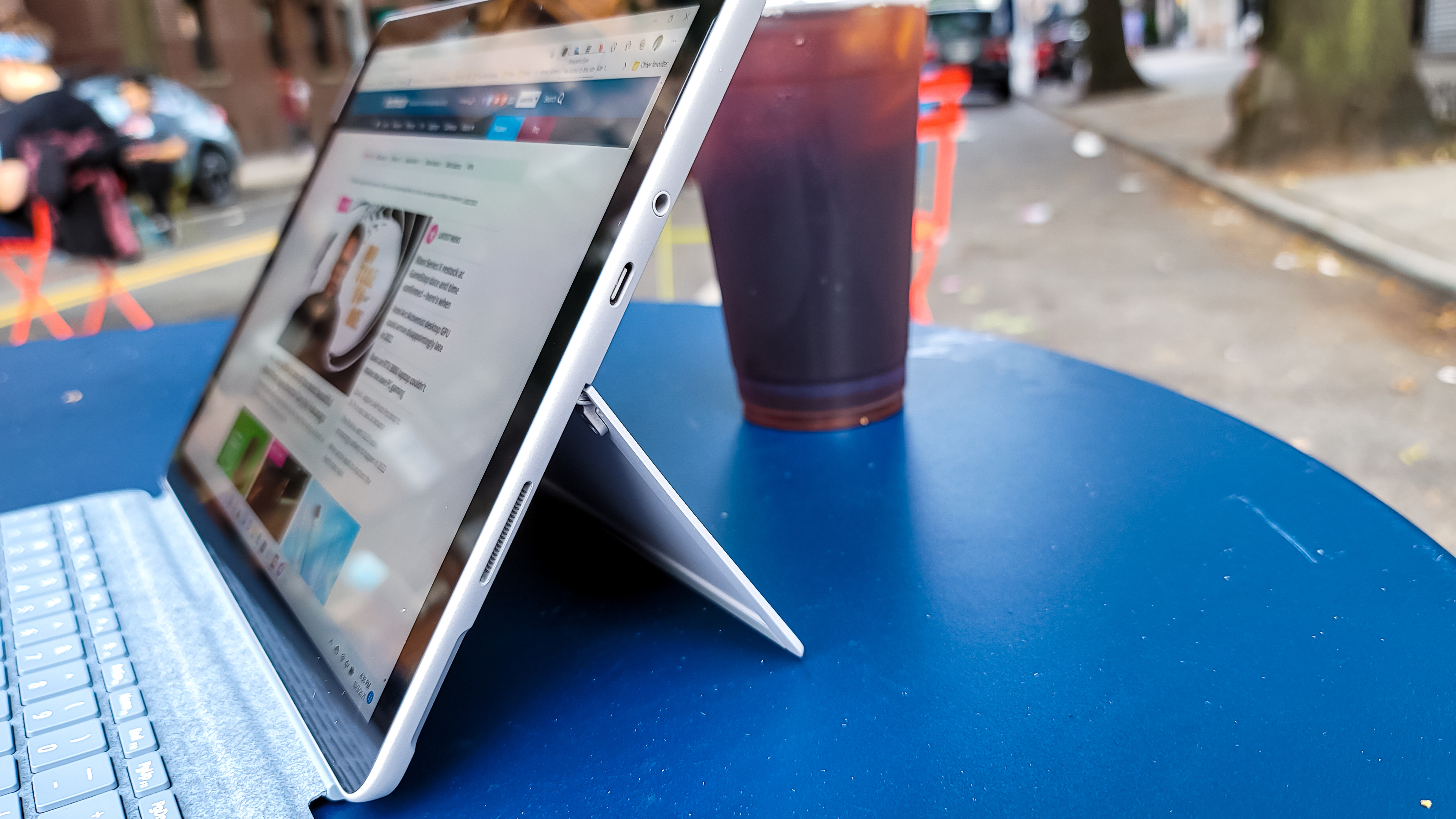
Just like any Microsoft Surface device, the Surface Go 3 is truly a gorgeous little laptop, rivaling that of the iPad, especially the iPads available at this price point. It’s incredibly thin at just 0.33 inches thick, and weighs just 1.2 lb, making it the ideal device to carry around if you don’t want to go out with a hulking backpack every time you just want to get some work done at the coffee shop.
The model we have in has the classic silver Surface aesthetic, with the Windows logo in a gorgeous chrome finish on the back of the device, on its hinge, where it’s going to get the most attention. From behind, this is one of the more attractive devices you’ll probably see in a café, but it’s a different story from the front.
Not a lot has changed in the Surface Go’s design since the Surface Go 2, which means the chunky bezels are back again. It is a tablet, which means people will need a little bit of space for just holding the device, but there are so many tablets out there that have solved this problem already – including Microsoft’s own Surface Pro 8 – that it really feels like a relic. But, again, this is a budget device, so we’re not expecting a truly extravagant piece of tech here.
Between the bezels is a 10.5-inch 1,920 x 1,280 display. A 1280p display isn’t exactly impressive on its own, especially in 2019, but given its price point, Microsoft could have easily given this a 720p display and called it good, and we’re glad it didn’t. But don’t expect a totally beautiful display, either.
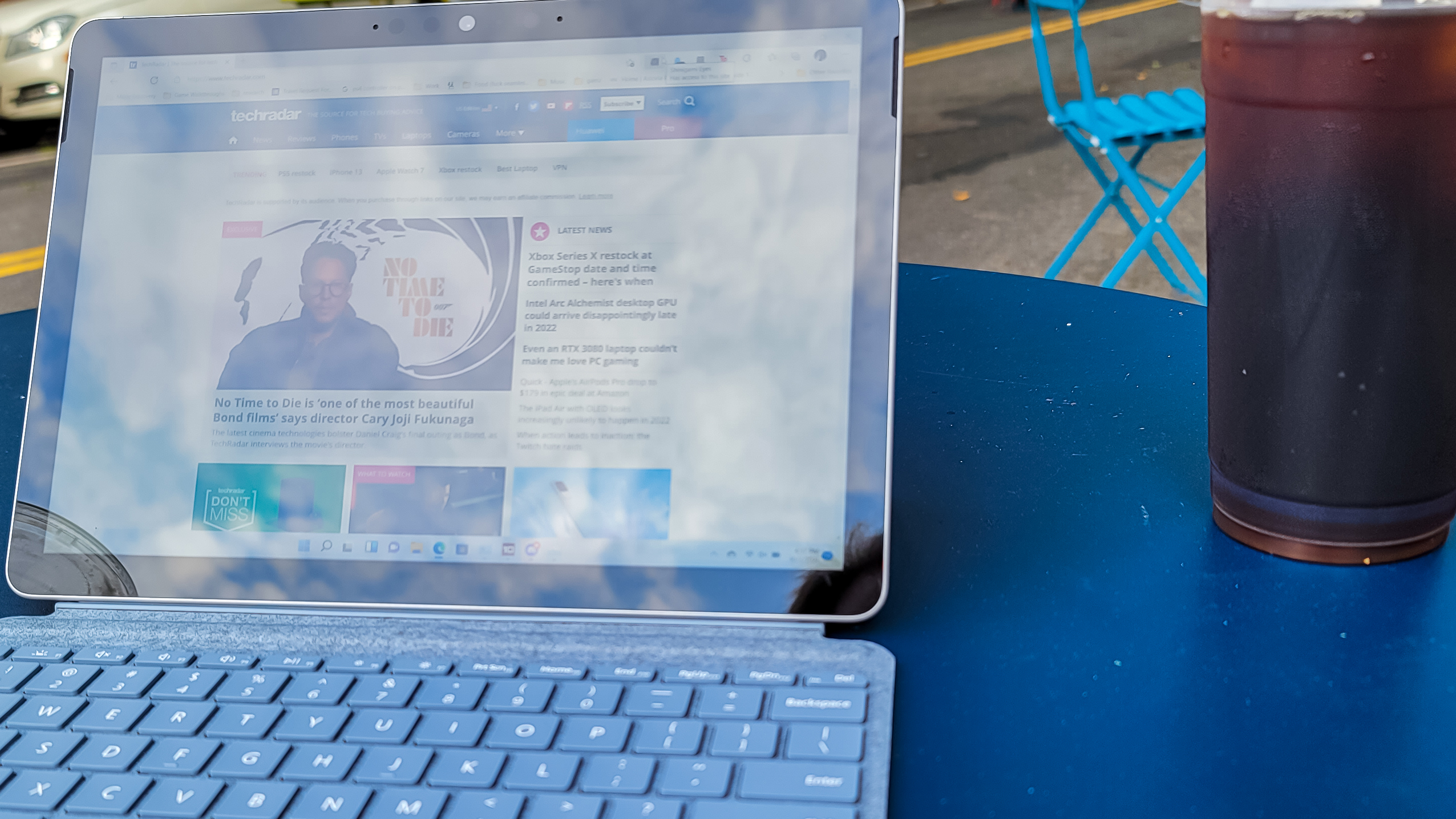
The screen isn’t especially bright, and color accuracy is a bit lacking. Watching animated shows like Sailor Moon or Bob’s Burgers clearly reveals how lacking this display is in this area. Neither of these shows really need a high-resolution display, but they are extremely colorful and show how shallow the color representation here is. Colors appear a bit washed out and bland, which isn’t the end of the world but it is a bit disappointing in a ‘PixelSense’ display.
Speakers are similar. They’ll provide a pretty decent experience if you just want to watch the odd YouTube video or watch some Netflix in your downtime, but they’re not exactly great for listening to music. Though they are positioned near the top of the screen when the Surface Go 3 is in its laptop mode, which means there is minimal distortion. One of the benefits of a tablet.
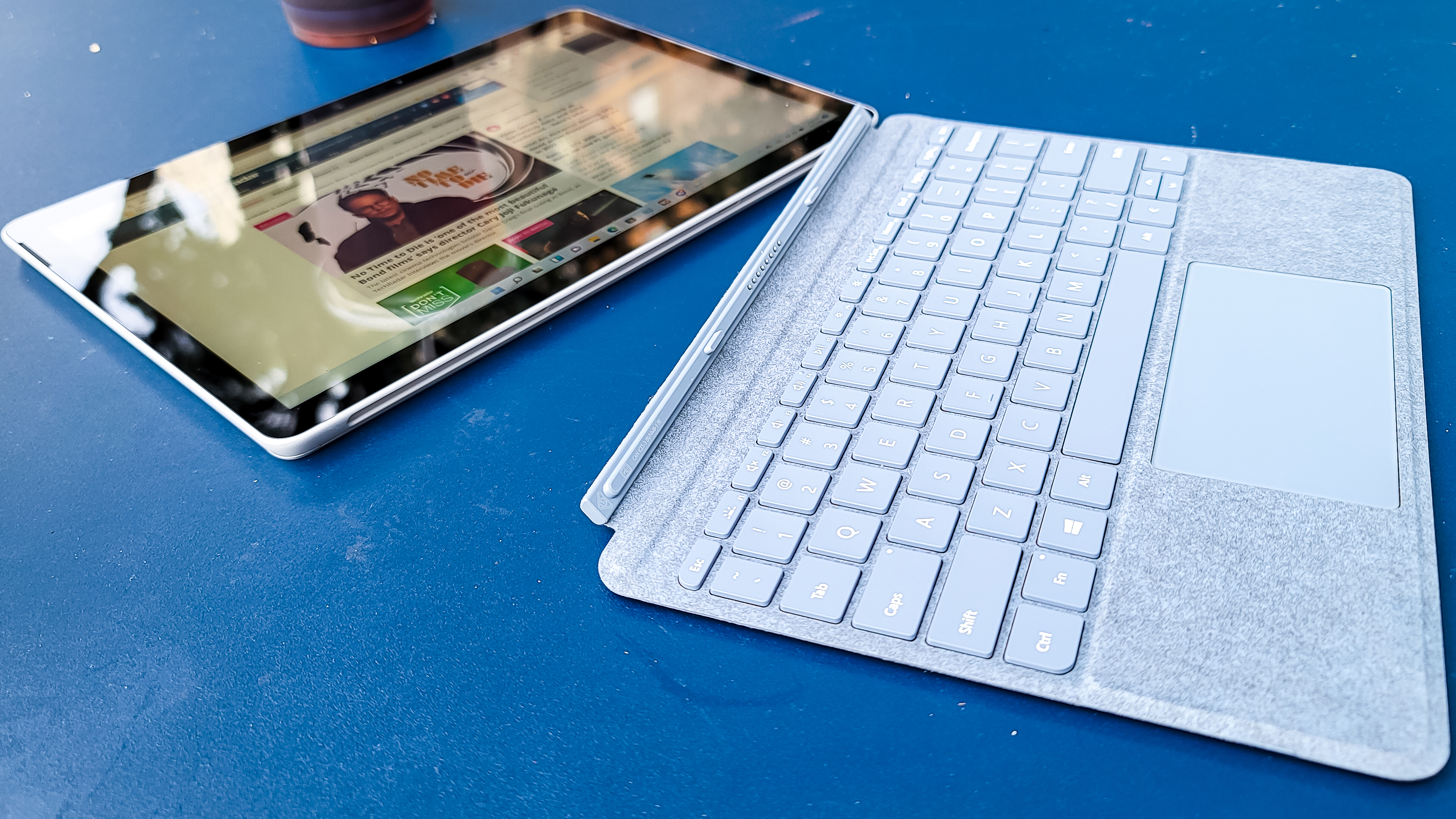
Speaking of laptop mode, the Surface Go 3 does not come with the Type Cover – which is definitely a knock against its value – but especially if you’re going to be doing some schoolwork, it’s essential for this device. Call us old-school but we still think that a keyboard and mouse is still the best way of navigating Windows, and that includes Windows 11, even with all of the improvements that Microsoft has included.
As for the Type Cover itself, it’s as good as ever, and has not changed. It’s still surprisingly comfortable to type on given its low profile, with plenty of key travel. However, with a keyboard made for a device this small, it will take some getting used to how close the keys are together. We have pretty small hands, and even we still find ourselves making mistakes when trying to touch-type.
The Type Cover also has a trackpad, and it’s passable. But this device excels when you use the touchscreen instead, especially if you just need to scroll down a document or web page or hit a quick button. Although, we find the gestures on the trackpad to be indispensable, so we still can’t see ourselves seriously using this device for work without the Type Cover – another reason Microsoft should just include it as standard. Microsoft stopped including it years ago and we will absolutely not stop complaining about it being sold separately until they include it again. Admittedly, this probably won’t happen, but we can dream, can’t we?
While we do think that the Type Cover is indispensable for using the Surface Go 3, that’s not the only accessory that’s core to the Surface experience – there’s also the Surface Pen. This is also not included, but it’s honestly one of the biggest selling points for any Surface device and it feels excellent, whether you’re writing down notes or doing some sketching in Photoshop. Yes, the Surface Pen is an incredibly expensive addition and we wouldn’t say you need it, but it is a nice-to-have if you can afford the extra $99.
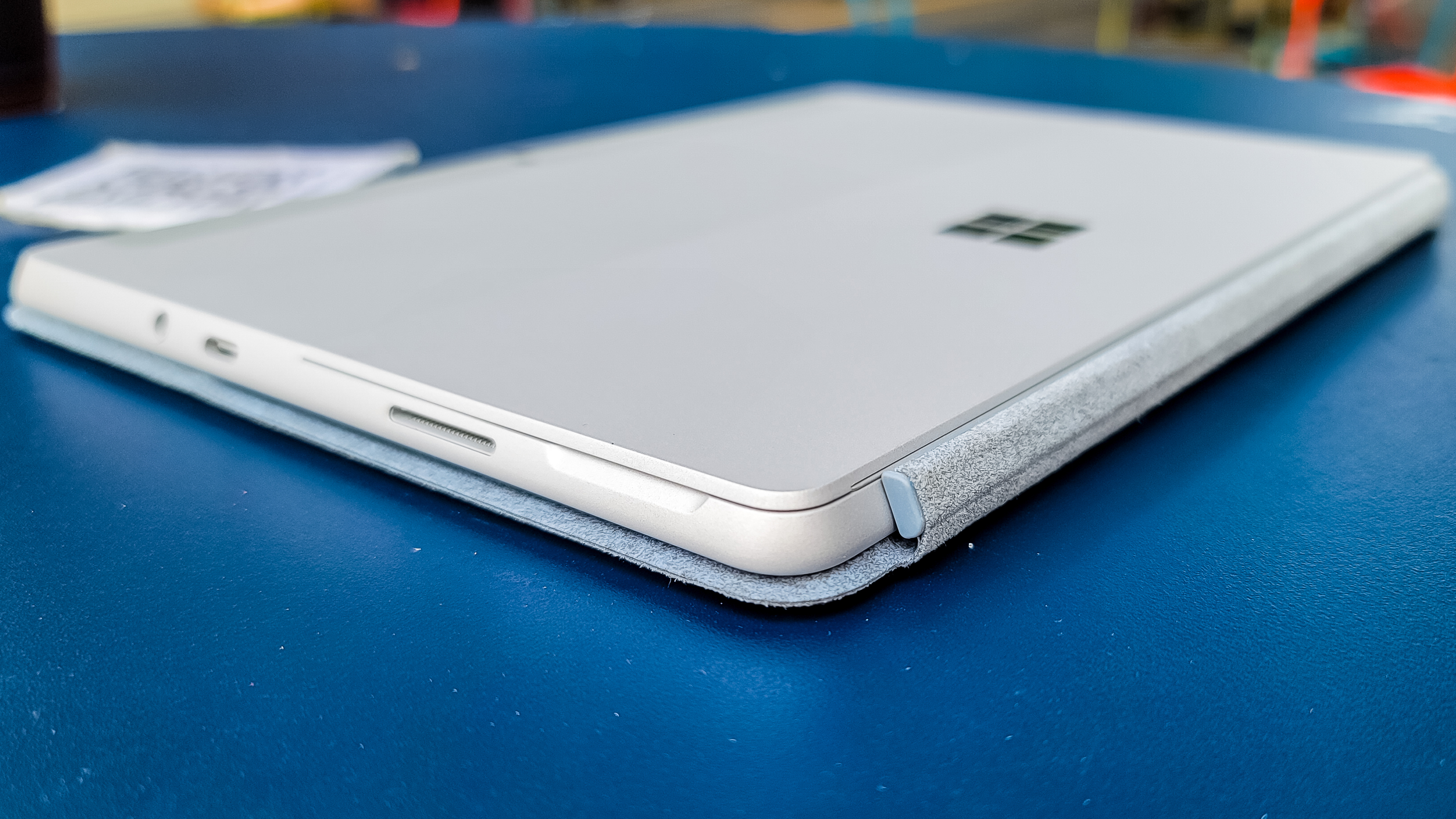
As for ports there isn’t much here, as to be expected in a device this small. On one of the narrow sides of the tablet are all 3 ports, and you’ll get a Surface Connect port, a USB-C (Thunderbolt 4?) and a combo 3.5mm audio jack. Honestly, it’s not a lot, but with a device like this, that’s to be expected. On the side of the laptop, you’ll find a power/lock button and a volume rocker. The volume buttons are likely just there to be used when the Surface Go 3 is being used as a tablet, but even in laptop mode, they’re super nice to easily reach up and adjust the volume.
Performance
Here’s how the Surface Go 3 performed in our suite of benchmark tests:
Cinebench R20 CPU: 1,277 points
3DMark Time Spy: 322; Fire Strike: 789; Night Raid: 3,584
GeekBench 5: 907 (single-core); 1,546 (multi-core)
PCMark 10: 2,596 points
PCMark 10 Battery Life: 6 hours 25 minutes
Battery Life (TechRadar movie test): 4 hours 39 minutes
The Surface Go 3 we’re reviewing here has an Intel Core i3-10100Y processor, 8GB of RAM and a 128GB SSD. So, needless to say, it’s definitely not the fastest device in the world. That processor is a 2-core, 4-thread fanless chip with a base clock of just 1.3GHz, which means it will absolutely start to struggle as soon as you ask it to do any kind of multi-tasking. And don’t even think about trying to do any kind of heavy creation workloads on this thing.
In Cinebench R23, the Surface Go 3 scores just 1,277 points which is nearly four times slower than the Surface Pro 8, and this SKU is a little over half the cost. And in PCMark 10, we get a score of just 2,596 points, which is the lowest score we’ve ever seen in that test. But laptops are one thing, it’s also important just how this laptop handles day-to-day.
And, well, that’s not great either. Whenever we’re just looking at, like, one webpage and chatting in Slack, the Surface Go 3 holds up alright. But as soon as you try installing an app or running any kind of media – like Spotify – in the background, you can start to run into slowdowns. This wasn’t such a big deal a couple years ago, before we all started having to work and learn remotely, but if there’s anything these last couple of years has taught us, it’s that hardware that’s easily able to handle multitasking is invaluable.
Because now that our PCs are one of the main ways we interact with the world, they just can’t be single-purpose devices anymore, and that goes for pretty much everyone. The pandemic has made multitasking so important, and it really is a shame that this device puts so much emphasis on the design instead of the internals. We would much rather have seen a less flashy aesthetic if it meant that it didn’t slow down when doing simple everyday tasks that everyone is going to have to do.
We don’t know if this is an issue with Windows 11, but it’s not exactly new. Windows has become more and more hardware intensive as time goes on to power flashier animations, but it means that low-power devices like the Surface Go 3 simply don’t work as well as they have to. And that’s one of the reasons that if you’re looking at a device in this performance tier, we wouldn’t recommend the Surface Go 3, we’d recommend a Chromebook – those might have similar specs, but the software is so much more adept at operating with it.
Camera and microphone
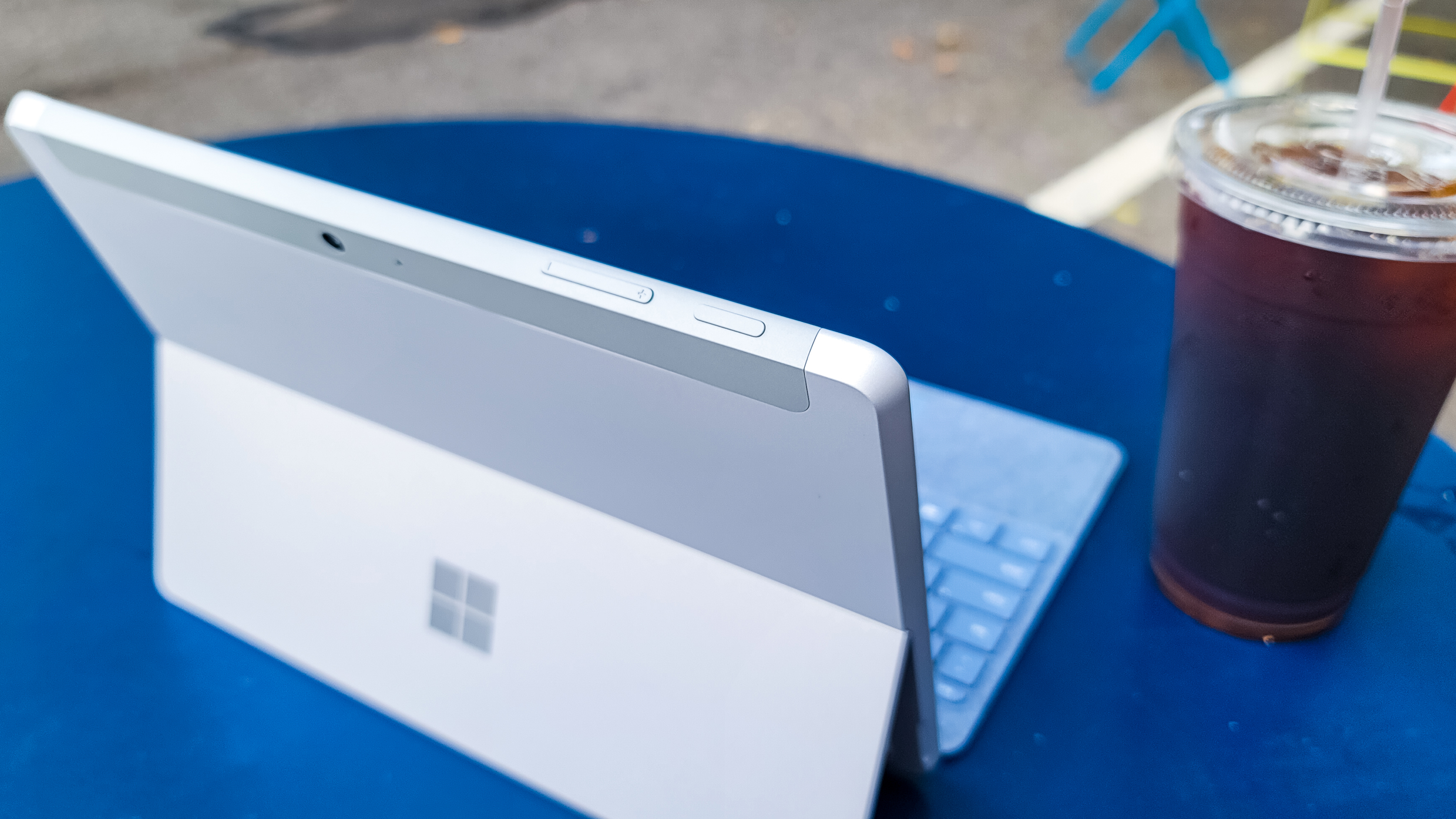
Microsoft has clearly put a lot of thought into making the video calling experience excellent on the Surface Go 3, which isn’t too surprising given how central Microsoft Teams is to Windows 11 in general. The webcam on this thing is absolutely amazing, easily capturing all the detail in our face without washing out colors or catching extra bloom in the background.
We’ve been taking a lot of video calls with the Surface Go 3, both through Teams itself and through Google Hangouts and Discord, and we haven’t heard a single complaint. The microphone is also simply excellent, capturing our voice without any distortion, and we don’t have to repeat ourselves because something wasn’t picked up.
And of course the webcam supports Windows Hello, and it is the best integration we’ve seen yet. It logs us in incredibly quickly, even when we have a facemask on our chin while we’re sitting outside a coffee shop or when we’re wearing a ton of eyeliner after a night out.
Video calls are a huge part of all our lives these days to be sure, and Microsoft has knocked it out of the park here. This is the one area that the Surface Go 3 truly excels at its price point. If you’re doing a lot of video calls and you want something portable that has a webcam that doesn’t suck, the Surface Go 3 is going to be an excellent choice.
Battery life
The Surface Go 2 didn’t exactly have the best battery life in the world, but it was fine. But the Surface Go 3 is a massive disappointment and has gone completely backwards in this regard. In the PCMark10 battery test, which emulates a bunch of real-world workloads like text editing and video calls, the device lasts just 6 hours and 25 minutes.
That’s usually what we see in a gaming laptop with super high-power graphics and a high resolution display, not in a tablet with a low-power fanless chip and a 1080p display. Battery life this short is frankly embarrassing for a tablet like this, and it’s not just the benchmark, either. Just taking an hour at our local coffee shop to write out this review in Microsoft Word saw our battery drop from 100% to 70% in just around 35-45 minutes.
We had the screen at full brightness because we were working outdoors, but still this is a Y-series chip and should absolutely have longer battery life. One of the main selling points of this series of Intel processors is its power efficiency, so we simply cannot wrap our heads around why the battery life is so bad here – and it’s not a Windows 11 thing because the other Surface devices last much longer.
The Surface Laptop Studio, for instance, lasts nearly twice as long as the Surface Go 3, and that laptop has a high-performance Tiger Lake H35 processor. There is simply no excuse for battery life this short. Period.
Software and features
One of the major reasons to buy a Surface device in the first place is that you’re kind of getting a pure version of Windows that you really won’t find elsewhere unless you build a PC yourself. There is no bloatware here, just a pure and simple Windows 11 installation. It’s something we’ve always loved about the Microsoft Surface lineup, and especially at this price point it’s not something you should take for granted.
Usually when you buy a Windows laptop for this cheap, you’re going to be inundated with a load of useless bloatware that will fill your screen with pop-ups and ads – it’s simply be a headache to deal with, especially if you’re not super familiar with digging around the Windows 11 settings app.
Instead, the Surface Go 3 provides you an essentially blank canvas to let you choose how you want Windows to work for you. That’s Microsoft’s whole thing, after all, and the reason why Windows 11 is still as open as it is. Now, the model we’re reviewing here is the commercial version, which ships with an unlocked version of Windows 11 Pro, which means we’re able to install whatever we want without having to disable anything.
For most people that buy this tablet off the shelves of their local Best Buy (or regional equivalent), the laptop is going to ship with Windows 11 Home in S-Mode. This is probably for the best, as it will help with the low-end hardware, and will be safer for students that probably aren’t as jaded by the internet as we are at this point. That does mean that you won’t be able to install things you download online right out of the box, but it’s relatively easy to disable S-Mode in the Settings app, and we have a guide here.
